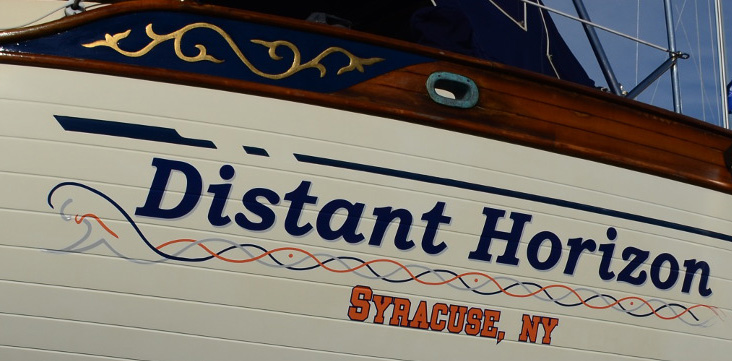For more years than I can remember, I dreamed about sailing across the Atlantic. I dreamed of what it would have been like on the Rosalie with uncle Edward. Then I dreamed of sailing on the Atlantic in my own boat. It seemed to be a fitting way to honour the man who ignited my passion for all things nautical.
Linda and I talked about all the details of this adventure. First we needed a boat. Then I needed to fill the voids in my sailing skills. Most importantly, We had to follow a simple creed; one which was drilled into me by my first flight instructor, Jim: "Safety First". As usual, Linda was completely supportive.
It had been many years since I stepped on a sailboat. So, I started looking for a small 24-26 foot boat. Linda came home the next day from work and asked what I thought about this boat and handed me a printout. It was a 32 foot boat!
This was to be our first Distant Horizon; a Columbia Payne 9.6. We sailed this boat on Seneca Lake for one season before moving her to the Great Lake Ontario. This was a more fitting body of water for the boat and preparation for my dream.
 |
| Distant Horizon anchored in Carlton Island's South Bay |
Our tentative plan was to use Lake Ontario as a proving ground for the boat. Then, I would sail her to Bermuda as a sea trial to test the boat and myself for the transatlantic voyage. While talking with the head of the US Coast Guard's cartography group, he asked why I was sailing on Lake Ontario. I explained to him the plan. He just laughed, then told me about his Coast Guard adventures, which started with a 6 year tour on Lake Ontario. His advice was to go to Bermuda, it would be a good sea-trial for Lake Ontario!
Linda had cancer. Each year, the doctors would discover a mass, always in early May. Linda would have treatments and when she felt better we would go sailing. Our sailing seasons were growing shorter. I would use the time we weren't sailing to do work and make changes to the boat.
During the winter of 2013 Linda asked how long would it take me to finish the work I was doing on the boat. I told her I needed 3 months starting with warmer weather. The next day Linda told me that we needed a new boat; one that was ready to sail. I told her we could get a small boat, but she wanted to get one that could also fulfill my dreams.
In the spring of 2014 we had another boat and named that Distant Horizon. Most people serialize their boat name with a roman numeral. I did not like Distant Horizon II as a name. Linda came up with the name originally and I wanted to keep that name. The official name identifying a boat is the name plus the port of call. The Columbia was Distant Horizon, Fair Haven, NY. So, the new boat became Distant Horizon, Syracuse, NY.
I know uncle Edward would approve of Distant Horizon. He loved teak, and Distant Horizon is adorned with lots of teak on the outside as well as the interior.
Linda had cancer. Each year, the doctors would discover a mass, always in early May. Linda would have treatments and when she felt better we would go sailing. Our sailing seasons were growing shorter. I would use the time we weren't sailing to do work and make changes to the boat.
During the winter of 2013 Linda asked how long would it take me to finish the work I was doing on the boat. I told her I needed 3 months starting with warmer weather. The next day Linda told me that we needed a new boat; one that was ready to sail. I told her we could get a small boat, but she wanted to get one that could also fulfill my dreams.
In the spring of 2014 we had another boat and named that Distant Horizon. Most people serialize their boat name with a roman numeral. I did not like Distant Horizon II as a name. Linda came up with the name originally and I wanted to keep that name. The official name identifying a boat is the name plus the port of call. The Columbia was Distant Horizon, Fair Haven, NY. So, the new boat became Distant Horizon, Syracuse, NY.
 |
| Distant Horizon at dock in Annapolis, MD |



